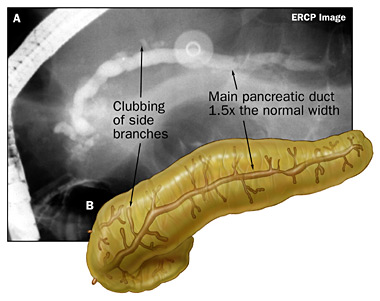Pancreatitis Diet..Always check with your doctor before changing your diet.....
If you have vomiting, pain, and nausea: go to hospital. You should be kept well hydrated and nourished by use of IV.
Bowel sounds returning, pain subsiding, nausea lessening: Clear liquid diet
Water
Clear juices like apple juice
Popcycles (not red or grape)
Jello (not red or grape)
Clear fat free broth (chicken, vegetable or beef
If you tolerate the clear liquid diet well, and bowel sounds are good, and things tend to be moving, you could move to the solid liquid diet:
Everything on the clear liquid diet
Cottage cheese
Ice cream
Pudding
If that is well tolerated for a day or two, and bowels are still moving well, you may move to soft diet:
Everything on the solid liquid diet
Extremely well cooked veggies, not of the **cruciferous family
Canned fruits (not raw)
A small piece of very lean meat, usually boiled and patted dry
If that is well tolerated for a day or two, and bowels are still working well, you might move to a bland diet:
Everything on the soft diet
Toast/bread
Jellies
Bananas
White rice, no fat
Melon..
If that is well tolerated, and the bowels are working well, you might move to the Pancreatitis diet: Low Fat, Low Protein, High Carbohydrate Diet..
You can eat what you want that is basically low fat.
..
Fats: Your diet should contain 30g fat per day. Your doctor may advise you to take MCT oil (to prevent fat malabsorption).
Saturated fat is most often found in animal products, such as red meat, poultry, butter and whole milk. Other foods high in saturated fat include coconut, palm and other tropical oils. Saturated fat is the main dietary culprit in raising your blood cholesterol and increasing your risk of coronary artery disease. Limit your daily intake of saturated fat to no more than 10 percent of your total calories. For most women, this means no more than 20 grams a day, and for most men this means no more than 24 grams a day.
Carbohydrates: Get 45 percent to 65 percent of your daily calories — at least 130 grams a day — from carbohydrates. Emphasize complex carbohydrates, especially from whole grains and beans, and nutrient-rich fruits and milk. Limit sugars from candy and other sweets.
Cholesterol is vital to the structure and function of all your cells, but it's also the main substance in fatty deposits (plaques) that can develop in your arteries. Your body makes all of the cholesterol it needs for cell function. You get additional cholesterol by eating animal foods, such as meat, poultry, seafood, eggs, dairy products and butter. Limit your intake of cholesterol to no more than 300 milligrams a day.
Fiber is the part of plant foods that your body doesn't digest and absorb. There are two basic types: soluble and insoluble. Insoluble fiber adds bulk to your stool and can help prevent constipation. Vegetables, wheat bran and other whole grains are good sources of insoluble fiber. Soluble fiber may help improve your cholesterol and blood sugar levels. Oats, dried beans and some fruits, such as apples and oranges, are good sources of soluble fiber. Women need 21 to 25 grams of fiber a day, and men need 30 to 38 grams of fiber a day.
Protein is essential to human life. Your skin, bones, muscles and organ tissue all contain protein. It's found in your blood, hormones and enzymes too. Protein is found in many plant foods. It comes from animal sources as well. Legumes, poultry, seafood, meat, dairy products, nuts and seeds are your richest sources of protein. Between 10 percent and 35 percent of your total daily calories — at least 46 grams a day for women and 56 grams a day for men — can come from protein.
Each person is different! Stay away from foods that disrupt your digestion! If you choose foods that are low fat, low protein, high carbohydrate, it will be easier on your pancreas. It won't have to work so hard to digest foods. Some people can't tolerate dairy products. They don't bother me at all, so I eat them! Some people don't tolerate wheat products, or products made from corn, but I have no problem with them! Once you on the Pancreatitis Diet, start a food log or diary. Start periodically adding a new food (just one at a time) and after a while, you will be able to tell whether or not this food agrees with you. As you find foods that you tolerate well, move them to your "Foods to eat" category. If you find a food that you don't tolerate well, move it to your "Foods to stay away from" category. After a while, you will see that you have a myriad of foods from which to choose!
..
**Cruciferous family:
- Broccoli
- Cabbage
- Cauliflower
- Brussels sprouts
These are hard to digest and may cause gas and tummy problems.
Other possible tummy troublers:
- Carrots
- Raisons!
These are not from the cruciferous family, but none-the-less are hard to digest and may cause gas and tummy problems.
..
Here is a list of difficiencies and symptoms of dificiency:
..
Deficiency. / Symptom
Protein-............low energy- apathy, fretfulness, low interest in food
Thiamin- .........confusion, irritability, memory loss, depression
Riboflavin- ......depression, hysteria, psychopathic behavior
Niacin- .............irritability, memory loss, mental confusion
Vitamin B6- ....irritability, depression, abnormal brainwave patterns
Folate- ............ mental symptoms of anemia, irritability, depression
Vitamin B12- ..degeneration of the peripheral nervous system
Vitamin C- ......hysteria, depression, lassitude, social introversion
Vitamin A- ......anemia
Iron- ................irritability, weakness, headaches
Magnesium- ...apathy, personality changes
Copper- ...........iron deficiency anemia
Zinc- ................iron deficiency anemia, irritability, emotional
..........................disorders
..



